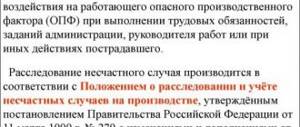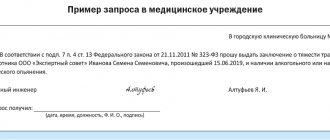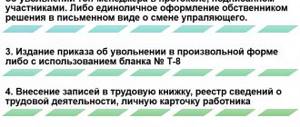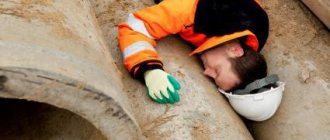Enterprises or organizations daily produce products or perform other equally important functions. The risk of danger is present everywhere, and it does not always depend on the employer or employee. The occurrence of injuries is inherent in all enterprises, so it is important to know the procedure for dealing with an accident at work in order to be able to correctly and adequately assess the current situation.
Basic concepts about injuries
What are work injuries and how are they classified?
No employer is immune from the investigation of a work-related injury, which means that the risk of injury at work exists literally everywhere. According to labor legislation, work-related injuries include:
- cuts, bruises, lacerations;
- fractures closed or open;
- poisoning with harmful or toxic substances;
- insect bites;
- burns and frostbite;
- and other health losses associated with work.
Injuries are classified:
- Lungs. In general, permanent disability does not occur; these include: sprains, minor bruises, scratches and abrasions. They are easy to treat while at home.
- Average. This type of injury is more significant in relation to the first one, since the loss of ability to work is longer. Injuries of this kind include open fractures, spinal bruises, and others. Treatment can be started in a hospital and completed on an outpatient basis.
- Heavy. This severity of injury takes the worker away from work tasks for a long time. In these cases, hospitalization of the employee is necessary. But there are also cases that end in death.
A medical specialist has the right to determine the degree of severity.
Classification of industrial injuries
There is a classification of injuries during professional activities by type, severity and number of victims (Table 1).
| Factors | Classification |
| By appearance | Mechanical injuries - bruises, fractures, abrasions Electrical shock or burns Thermal – burns, frostbite, heat stroke Combined – injuries acquired through the interaction of several provoking factors Chemical – acid or alkaline burns, chemical poisoning |
| By severity | Lungs – cuts, bruises Severe – fractures, traumatic brain injury, bruises of internal organs Fatal injuries |
| According to the number of victims | Single – 1 person was injured Group – more than 2 people injured |
Video about management actions:
Actions of an employee in the event of an accident
Procedure in case of an accident
While directly performing a production task or on the territory of the enterprise, an accident occurred with an employee. What is the procedure?
The procedure for action or action in the event of an accident at work by an eyewitness or eyewitnesses is as follows:
- The witness should first ensure his own safety and the safety of other workers so that the same thing does not happen to them. Take action if necessary.
- If necessary, first aid should be provided. First aid is not medical and everyone must be able to provide it.
- Be sure to report the incident to your immediate supervisor and call an ambulance.
- There is no need to restore order at the scene of the incident and put everything in its place, since an analysis will be carried out during the investigation of this area.
But there are different cases, for example, when a load hangs on a hoist and this poses a danger to others, then this problem should be eliminated, but it is still better to inform the manager.
Adviсe:
- There is no need to panic, this is life and there is always a place for unforeseen circumstances in it, the main thing is that all actions in the event of an accident at work are carried out in full.
- If you are not confident in the correctness of first aid, then it is enough to carry out basic measures, for example, give something to drink or throw warm clothes on the victim.
- There is no need to leave the scene until the injured person is taken to a medical facility. If possible, you can ask a few questions about how this happened.
- It is imperative to comply with the requests of the injured person.
Only skillful actions and calm will contribute to the progress of the investigation.
What should a leader do?
Actions of a manager in case of an accident at work
Upon receipt of information about the occurrence of an accident by the manager in the area entrusted to him, the latter must take the following actions in the event of an industrial accident:
- Notify senior management and the occupational safety representative.
- Assess the condition of the victim and immediately arrange for his delivery to the nearest medical facility, accompanied by a work colleague. In this case, it is necessary to prepare a request about the severity of the injury received.
- Assess the condition of the workplace where the incident occurred and give instructions to other employees: either fence off the area and not touch anything or eliminate the danger to others.
- Next, you should wait a pause for specialists to determine the severity. This is necessary to establish how the investigation will be conducted, including which committee should be appointed.
- The labor protection service must send information about the incident to social security. The time allotted for this is no more than a day, and the need is to calculate a percentage of payments to the victim.
Payment of compensation
In order to provide an injured person with benefits related to temporary or complete loss of ability to work, the management team must prepare in the Social Insurance Fund:
- A copy of the contract with the employee and work record book
- Final report of the injury
- An act fixing the terms and time of payment of benefits
An accident falls under an insured event, which means compensation to the victim is mandatory. There is a responsibility for covering up an incident. According to the article, the following types of fines are provided for concealing an incident:
- Up to 500 rubles for citizens
- From 500 to 1000 rubles for employees
- From 5,000 to 10,000 rubles for an enterprise
How the investigation is carried out
Procedure for conducting an accident investigation
The investigation of an accident begins with determining the category of the degree of injury, as mentioned earlier, this is done based on medical indications.
If the manager receives information that the injury is classified as minor, then the sequence of actions is as follows:
- An order is issued for the unit, which indicates: the period for conducting the investigation, it should not exceed three calendar days. The composition of the commission is also appointed, which should include a specialist from the occupational safety service and a representative of the trade union organization. It is important that the composition of the commission members be odd, since controversial issues may arise during the investigation, and only voting can a decision be made on how best to proceed in this situation. It is equally important to know that the employer himself does not need to be included in the commission, since he is an interested party.
- Next, an authorized member of the commission or a representative of the labor protection service takes an explanatory note from eyewitnesses and from the victim himself.
- It is necessary to conduct an inspection of the scene of the incident; be sure to draw a sketch with points of reference to existing building structures or equipment.
- If possible, you can take video footage of the place where the accident occurred.
- Take photographs of the scene of the incident.
- It is necessary to check the availability of instructions on labor protection, familiarization with enterprise standards, job descriptions and other local regulatory documents. If the employee performed work with lifting mechanisms, then it is necessary to check the presence of a slinger’s certificate and the certification period, as well as the presence of electrical safety group II. And if an employee worked with a computer, then at least he must have electrical safety group I. Along with this information, an assessment should be made of how the internship and admission to work were carried out. Work orders are checked - permits for hazardous work, if any were necessary. Copies of all listed documents must be attached to the case materials.
- Based on the investigations carried out, it is necessary to prepare an act in form N-1. That is, the commission reviews all materials and makes a decision to punish the manager and determine the degree of guilt of the employee.
The nuances of conducting an investigation into an accident classified as serious
Investigation of an accident classified as serious
If the injury is classified as severe, group, or resulted in death, then its investigation may include the following nuances:
- The commission should include a state labor safety inspector for a specific region.
- The investigation is given time of 15 calendar days.
- When working in hazardous industries, the presence of a Rostechnadzor inspector is mandatory.
- If the accident is related to mass poisoning, then a representative of Rospotrebnadzor is included in the commission.
The registration of the Act in Form N-1 is carried out in the same way as when investigating a mild injury.
Investigation details
The main task when investigating materials on an industrial accident is to identify the percentage of fault of the employer.
In view of this, some nuances are taken into account:
- The percentage of the employee’s degree of guilt should not exceed 25%. It is believed that the employee punished himself anyway. And if he performed emergency work as a result of an accident at the site, then the degree of guilt may not be indicated at all.
- The rest of the blame falls on the manager. In order to correctly record the non-compliance in the report, you need to find the required item in the labor protection instructions or other local regulatory document. Even if there is no signature to familiarize yourself with the orders of the enterprise, this does not exempt you from liability.
- Depending on the determination of the degree of guilt of the manager, penalties are determined. They can be either disciplinary, administrative or criminal, but can be imposed simultaneously.
In the details of the investigation, it is necessary to clearly indicate the testimony of the victim, since the victims themselves are often to blame for the incident. It is possible that, for example, they incorrectly hooked the load and worked with faulty removable load-handling devices. But it is better to present such materials in the victim’s explanatory statement.
Case from practice
A specific case at the production site of the YuganStroyTrans LLC enterprise (Table 2).
| Circumstances of the incident | What violations | Bottom line |
| A mechanic removed the protective cover from the grinding machine while performing repair work on a car. Started work. Despite the fact that numerous comments were made to the mechanic about the dangers of such work, he ignored everything. As a result of this negligence, the grinder ruptured and the worker was seriously injured. | Failure to comply with technical regulations, expressed in incorrect operation of equipment The employee was allowed to perform his duties without special training | Fine – 135,000 rubles |
Video about drawing up the act:
How the Act is drawn up in form N-1
The completed Report in Form N-1 is the final document regarding the investigation of an industrial accident.
Execution of the Act in form N-1
Recommendations for filling:
- The incident that happened to the employee is briefly and concisely described.
- The following is a description of the testimony of eyewitnesses and the victim himself.
- It is indicated which point from the regulatory document was violated by the victim and his immediate supervisor.
- Afterwards, by decision of the commission, the percentage of guilt of the injured employee and the manager is prescribed.
- The prepared document is signed by the members of the commission and approved by the chairman of the commission.
The act is stored in the enterprise archive for 45 years, which meets the requirements of legislative documents.
Legislation
Accidents that occur during work are regulated by the Labor Relations Code (Article No. 227). If the incident occurred as a result of an emergency, then Federal Law 125 applies. In certain situations, other acts may apply.
In case of unforeseen situations at work that result in injury or death of employees, special legislative documents are established. The employer is obliged to provide prompt medical assistance, notification of the relevant authorities and a thorough investigation of the incident.
What documents regulate the actions of employees at the enterprise?
Actions in case of an accident at work are laid down in the following regulatory documents:
- Labor protection instructions for specific professions or types of work. The last section usually indicates the actions of workers in emergency situations, as well as the rules for providing first aid.
- Manufacturing instructions. These regulatory documents regulate the activities of certain areas of industrial safety and actions in case of industrial injuries may also be specified in them.
- Enterprise standards. These local acts prescribe safety requirements and the main directions for action in the event of possible incidents.
- Regulations on accident investigation. This is the main document regulating the activities of enterprise employees in the event of industrial accidents. It indicates the forms of Acts N-1, forms of explanatory eyewitnesses and the victim. This is a reference book that every safety engineer should study.
All of the listed documents are developed taking into account actions in the event of accidents at work.









